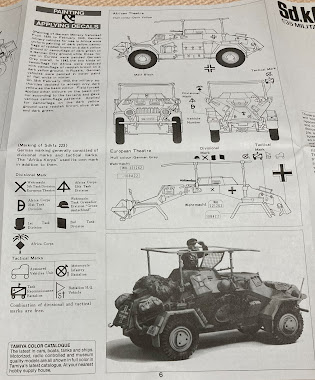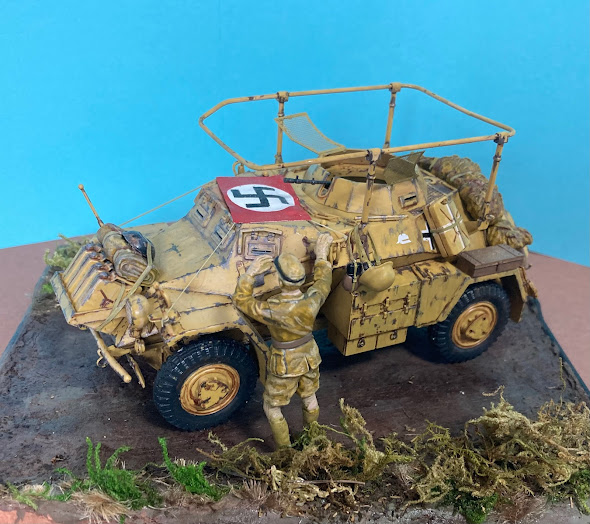 Tamiya Sd.Kfz. 223 Leichter panzerspahwagen Fu.
Tamiya Sd.Kfz. 223 Leichter panzerspahwagen Fu.
Tamiya Sd.Kfz. 223 Leichter panzerspahwagen Fu. Lifting the lid.
Building Tamiya's Sd.Kfz. 223 Leichter panzerspahwagen (Fu). The sand gets everywhere.
The Leichter Panzerspähwagen (German: "light armoured reconnaissance vehicle") was a series of light four-wheel drive armoured cars produced by Nazi Germany from 1935 to 1944... and I've made a model of one.
Tamiya Sd.Kfz.223 Leichter Panzerspähwagen(Fu)

As always I give everything a coat of base coat. Just in case I can't get a brush to it later.
Putting the subframe together.
Building up the underside of the hull.
See how I add the colour as we go.
Putting the body together. I'll leave the wheels for now. Access may be important later.
The rear-mounted petrol engine was originally a 3.5 Litre Horch V8 with 75 PS (55 kW; 74 hp) (Ausf. A chassis); from 1942, this was replaced by a 3.8 Litre with 90 PS (66 kW; 89 hp) (Ausf. B chassis), giving it a road speed of 80 km/h (50 mph) and a cross-country speed of 40 km/h (25 mph). It had a maximum range of 300 km (186 mi).
I'll construct the turret too, but I won't put it on yet.
Used by the reconnaissance battalions (Aufklärungs-Abteilung) of the Panzer divisions, the type performed well enough in countries with good road networks, like those in Western Europe. However, on the Eastern Front and in the deserts of the North African campaign, this class of vehicle was hampered by its relatively poor off-road performance.
Adding the mud guards.
So far, so good.
Adding the wheels radio aerial and the upper body furnishing.
Time for some paint. I:m going with the dark yellow scheme. There are plenty of others for you if you prefer.
This is a dark brown weathering.
And now some rusty chipping around the exposed edges.
Front and sides were made of 14.5 mm (0.6 in) 'rolled homogeneous armour' (RHA) a type of vehicle armour made of a single steel composition hot-rolled to improve its material characteristics, as opposed to layered or cemented armour. Its first common application was in tanks. Thinner 5 mm (0.2 in) plates protected the top, rear, and bottom. Cast vision ports were cut into the armour. The open-topped turret was fitted with wire mesh anti-grenade screens. Beginning in 1939, the front armour was increased to 14.5 mm (0.6 in).
 I think they overdid the chipping...
I think they overdid the chipping...Better add the turret. There are a lot of other items to add too. These items are straight out of the box. Plenty of things for us to play with here.
The turret was comparatively cramped and lacked top protection other than a wire screen designed to allow grenades to roll off, but this made using the main armament problematic.
Adding the final details. Helmets, water bottles and the photo etching.
Finally, the decals.

The 223 had of a frame antenna and a 30-watt FuG 10 medium-range radio set; full designation was Leichter Panzerspähwagen (Fu). Later versions of the vehicle were equipped with an improved 80-watt FuG 12 radio set. It was originally armed with an MG 13 machine gun, but in 1938 this was changed to an MG 34. The three-man crew consisted of a driver, commander and radio operator. Production ran from 1936 to January 1944, with at least 567 vehicles produced.
I'll need a base. That will be next I think.
 Tamiya Sd.Kfz. 223 Leichter panzerspahwagen Fu.
Tamiya Sd.Kfz. 223 Leichter panzerspahwagen Fu.
Tamiya Sd.Kfz. 223 Leichter panzerspahwagen Fu. Lifting the lid.
Building Tamiya's Sd.Kfz. 223 Leichter panzerspahwagen (Fu). The sand gets everywhere.



.JPG)

.JPG)

.JPG)
.JPG)
.JPG)





.JPG)
.JPG)












.JPG)
.JPG)



.JPG)












Comments
Post a Comment